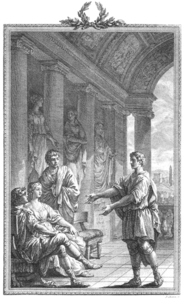Ezio (hate)
| Work data | |
|---|---|
| Title: | Ezio |

Second act, scene XIII. |
|
| Shape: | Opera seria |
| Original language: | Italian |
| Music: | Johann Adolph Hasse |
| Libretto : | Pietro Metastasio |
| Premiere: | Fall 1730 / January 20, 1755 |
| Place of premiere: | Teatro San Bartolomeo, Naples / Royal Court Theater Dresden |
| Place and time of the action: | Rome, AD 454 |
| people | |
|
|
Ezio is the name of two operas in three acts by Johann Adolph Hasse based on the libretto Ezio by Pietro Metastasio .
action
The libretto is about the Roman army master Flavius Aëtius , who is called Ezio in Italian. He had defeated the Huns under their leader Attila in the battle of the Catalaunian fields in 451 . After his return to Rome, he recognized the Western Roman emperor Valentinian III. (Valentiniano) a rival for his fiancée Fulvia. The patrician and imperial confidante Petronius Maximus (Massimo) organized an assassination attempt on Valentiniano and after its failure ensured that Ezio was suspected. Valentiniano wants to have Ezio killed. However, the murder is not carried out. In a subsequent popular uprising, Ezio saves Valentiniano. The two make up and Ezio can marry Fulvia.
First setting Naples 1730
Hasse's first setting of Ezio had its premiere in autumn 1730 at the Teatro San Bartolomeo in Naples . Francesca Cuzzoni , who was later engaged by Georg Friedrich Handel in London, sang along with it.
Cast for the premiere of the first setting
- Valentiniano III - Elisabetta Ottini
- Fulvia - Francesca Cuzzoni (soprano)
- Ezio - Carlo Scalzi (soprano)
- Onoria - Rosaura Mazzanti (Alto)
- Massimo - Francesco Tolve (bass)
- Varo - Mattia Mariotti
Second setting Dresden 1755
Hasse set the opera Ezio to music for the Dresden court for the second time in 1755. It was premiered on January 20, 1755 at the Royal Court Theater there. The production was one of the most spectacular and elaborate productions at the Dresden court and at that time as a whole, even more elaborate than that of Solimano , who had made headlines in a similar way. In this respect, the production of the second setting of Ezio joins the series of representational operas, i.e. H. those opera productions with which the Saxon royal court wanted to represent its power and potency.
Cast for the world premiere of the second setting
- Valentiano III - Ventura Rochetti (Soprano Castrato )
- Fulvia - Teresa Albuzzi-Todeschini (soprano)
- Ezio - Angelo Maria Monticelli (mezzo-soprano / alto castrato)
- Onoria - Caterina Pilaja (soprano)
- Massimo - Angelo Amorevoli (tenor)
- Varo - Giuseppe Belli (Soprano Castrato)
Contemporary description
Because the production caused such a furore, it was discussed in several newspapers and independent publications - more extensively than most other operas at the Dresden court. The elaborate backdrops for which Jean Hieronymus Servandoni was specially hired from France were particularly emphasized .
A detailed description can also be found in Moritz Fürstenau as well as in literary-satirical exaggeration by the "German French" Johann Christian Trömer (see web links).
Web links
- Ezio (Johann Adolf Hasse) in the Corago information system of the University of Bologna
- Libretto record Naples 1730 in the Corago information system of the University of Bologna
- Libretto Dresden 1755 (Italian and German) . Digitized version of the University and State Library of Saxony-Anhalt
- Moritz Fürstenau : On the history of music and theater at the court of the electors of Saxony and kings of Poland. Friedrich August I. (August II.) And Friedrich August II. (August III.). Rudolf Kuntze's publishing house, Dresden 1862, pp. 282–285. Description of the world premiere of the second setting.
- Johann Christian Trömer : From Opera Ezio, all decorations, from preciously beautiful elevator k ehn klehn Description. In: Schrifften: with a lot of nice Kuffer Stick Kanß Complett. Vol. 2, pp. 258-272. Detailed satirical description, unfortunately without "Kuffer Stick"